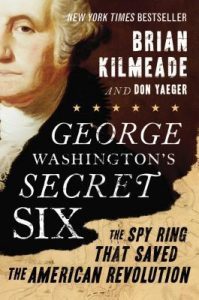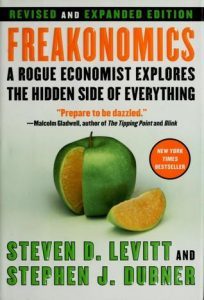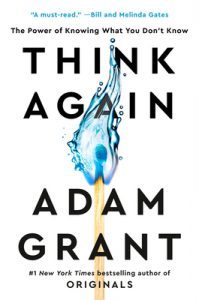C.A. Gray's Blog, page 38
July 30, 2021
George Washington’s Secret Six, by Brian Kilmeade
This week’s podcast review comes from this blog review of George Washington’s Secret Six
The post George Washington’s Secret Six, by Brian Kilmeade appeared first on C.A. Gray.
July 23, 2021
Freakonomics by Steven Levitt and Stephen Dubner
This week’s podcast review comes from this blog review of Freakonomics.
The post Freakonomics by Steven Levitt and Stephen Dubner appeared first on C.A. Gray.
July 20, 2021
Review of Conspiracies and Conspiracy Theories

Most of the Great Courses skew heavily left, and with a topic like conspiracies and conspiracy theories, I was bracing myself for a one-sided liberal rant against the idiocy of conservatives. But I have to hand it to the author/lecturer: while it’s clear that he identifies as liberal, for the most part he was quite fair and balanced. He made the point early on that there is (and should be) a distinction between conspiracies and conspiracy theories, because of course, some conspiracies are true. The purpose of the book was to help the listeners identify which conspiracies are likely to be true, which are likely to be false, and how to tell the difference. This section was great–I even listened to it a second time so that I could take notes. He summarized his “BS detection” section with the statement that most conspiracy theories fail either the competency problem or the leakage problem: that is, too many people had to be in on it, had to be perfectly competent (which we all know isn’t likely with humans), had to not lose their nerve or have an attack of conscience or anything else, and had to maintain absolute secrecy after the fact. The wider the network of co-conspirators that would be necessary to pull this off, the more likely it is that the conspiracy is false. Then he gave examples throughout modern history as examples to illustrate his points, dissecting classics like the JFK assassination and (this one was new to me) 9-11 “truthers” who believe that it was an inside job. He even assigns ranks to certain types of conspiracy theories as being more or less likely to be true (without stating whether or not they are so) on the basis of his criteria.
The earlier section of the book discusses the psychological characteristics shared among those who tend to believe in conspiracy theories. This section seemed to assume that the conspiracy theories believed are false, since it discussed things like confirmation bias, cherry-picking data and examples, a psychological mismatch between the magnitude of an event and the seemingly random cause, which makes people want to assign the event a greater meaning.
Finally, the book ends with the flip side: tools used by real conspirators to obfuscate their intentions. They will deny or minimize the problem, call for more evidence, or blame-shift. They too will cherrypick their data to their own ends. They will attack the whistleblowers (the classic ad hominem approach). They will attack the alternatives to their own goals. Or, most Orwellian of all, they will hire front groups and fund scientists with conflicts of interest, set them up to appear independent and unbiased, and get them to argue their case for them.
Overall, very well balanced. I find having clear categories like this to be very helpful when approaching both sides of an issue.
My rating: ****
Language: I think once or twice
Sexual content: none
Violence: graphic depictions of history but that’s all
Political content: present but balanced, I thought.
The post Review of Conspiracies and Conspiracy Theories appeared first on C.A. Gray.
July 16, 2021
Review of George Washington’s Secret Six

This would make a great movie! It’s the untold (until the 1920s anyway) story of six spies during the Revolutionary War who fed critical information to George Washington at great personal risk, very possibly (as the subtitle says) influencing the war’s outcome. They were so secret that even Washington himself did not know some of their identities, and after the war was over, several of them were potentially regarded by their fellow Americans as traitors, so effective was their cover. This makes me so sad for them… it’s like (Harry Potter spoiler alert) Snape seeming like a villain to the entire wizarding community for the entire series, only to be vindicated after his death.
A series of letters were discovered in the 1920s just after WWI and before WWII, and because of this they went largely ignored at the time, to be unearthed yet again decades later. These letters revealed the identities of five of the six in the spy ring in great detail, showing how Washington decided upon the nature of the ring after learning what not to do through the tragic execution of Nathan Hale. It also described the critical information they fed to him which led to the downfall of not only Major Andre, one of the British spies, but also foiled Benedict Arnold’s plot to take over West Point. Had this succeeded, it almost certainly would have turned the war.
Only one of the Culper Ring was ever caught: Agent 355, the only female of the bunch and the only one whose identity has not yet been revealed. She may have died aboard the British prison ship, or she may have escaped and gone on to live a long life post-war. After the epilogue, the book includes the list of the top seven candidates for Agent 355, including the evidence both for and against each candidate.
How sad that people who risked so much never got any of the glory for it. But, that’s not why they did it.
My rating: ****
Language: none
Sexual content: none
Violence: present (it was war) but nothing too gratuitous
Political content: historical only
The post Review of George Washington’s Secret Six appeared first on C.A. Gray.
Think Again, by Adam Grant
Today’s podcast review comes from this blog review of Think Again by Adam Grant.
The post Think Again, by Adam Grant appeared first on C.A. Gray.
July 9, 2021
Review of Freakonomics

Given how polarized the world is now, I’ve been spending a lot of time lately wondering how decent, intelligent people can come to such wildly different perspectives that they can no longer even have a conversation with each other. I’d already listened to “Understanding Complexity,” which made me almost despair of anyone ever knowing anything. Any given person can only focus on some 1% of the data he perceives at any given moment, and on top of that, in this global interconnected world, all the variables “dance,” influencing one another in real time. Then I listened to “Think Again,” which (while rather hypocritical of the author, I thought) made the point that we should be humble enough to be open to outside information which might change our perspectives. These two messages are certainly compatible, though they still leave a question of how one is to actually arrive at any conclusions with enough confidence to make decisions and live one’s life.
That made this book a logical next step. I read it once before maybe 15 years ago, and at the time it blew my mind. I’m not a very “outside the box” thinker in most cases, unless someone draws my attention to the alternatives. This book is all about thinking outside to box, seeing associations and correlations in surprising places, and then investigating the data to determine if correlation = causation. Tempered with the message of “Understanding Complexity,” I went in with the question of, yes, but how can you know if the variable you choose is the only one, or the primary one? How do you know which variables are the “signal”, and which are the “noise”?
I’d forgotten the main premise of this book, though, which was that while morality is the study of how things should be, economics is the study of how they actually are (whether money per se is technically involved or not). Find the incentive, and you’ll find the human cause of any economic phenomenon. Incentives can range from social (shame and guilt) to financial (paying late fees for bad behavior, cash rewards for good behavior) to fear of loss or punishment. The authors postulated the rather pessimistic view that while there is such a thing as altruism (the pleasure one gets in helping others), anyone will violate his own moral code at the expense of others if the incentive is strong enough. Using this as a guiding principle, they proceeded to investigate real-world examples. Once they found the incentive, they followed that “signal” right to the smoking gun. Parents feel some guilt for leaving their kids at daycare an extra hour so that the teachers can’t go home, and this is a motivating factor that curbs incidence of it… but if the daycare institutes a small late fee, the incidence of late pickups increases, because the parents just bought off their guilt. People donate blood because it makes them feel good about themselves, but if you start to pay them for their blood, it becomes purely mercenary, and donations decrease if the amount is too low to serve as adequate compensation for the feeling they got from an act of altruism. If it’s too high, you may inadvertently inspire a black market in which people are forced to give up their blood at knifepoint. If teachers are rewarded financially for class performance, you’ve just given the teachers motivation to cheat on standardized testing (and indeed, some did: they found the evidence and fired the teachers). While in general people might have good will toward others, the second one’s own interests come in conflict with those of someone else, if the inducement is strong enough and the deterrents against it low enough, his own interests will win every time.
Put another way, mankind is inherently selfish, or sinful. This was especially interesting to me, as I had postulated (to myself) one unifying “signal” that might explain the differences in worldview between the two polar extremes of today, liberals and conservatives: in general, conservatives are religious to some degree. They believe in God. From this follows that man is inherently sinful and in need of redemption. Given the opportunity and sufficient motivation, we will, as a species, seek our own good at the expense of others. From a belief in God also follows that there is a moral law, His law, which is outside of ourselves. We didn’t create it, but we inherently know it. That means there is right behavior that is always right, and there is wrong behavior that is always wrong. One should never lie, cheat, steal, murder, or any of the other Ten Commandments–no matter how strong the incentive. On the other hand, in general, liberals are not religious. They tend to believe in mankind’s inherent goodness, not that he is in need of any kind of redemption–who would give it? Given the opportunity, liberals tend to believe that utopian societies are possible, and that we will all share and care for our fellow men in need, regardless of the cost to ourselves. Those who are irreligious also cannot logically believe in an absolute moral code–after all, if there is no God, where would it have come from? What we call “right” and “wrong” they must believe stems from evolutionary advantages and disadvantages to the species. From this it follows that morality is relative to the benefit to the greatest number of people; the end justifies the means. If many would benefit (or they think many would benefit) from a single act which might seem immoral on its face–well then, why not lie, cheat, or steal?
I think the difference between today’s diametrically opposed worldviews really comes down to what we do with God. He’s either at the center of everything, or He’s not. If He’s not, any worldview based upon Him must be wrong. If He is, then any worldview that doesn’t take Him into account must be wrong. “The fear of the Lord is the beginning of knowledge, but fools despise wisdom and instruction” (Proverbs 1:7).
My rating: ****
Language: very minor, only when quoting people
Sexual content: none (it’s nonfiction)
Violence: none (it’s nonfiction)
Political content: I’d say none–some political topics are brought up but not from a partisan point of view
The post Review of Freakonomics appeared first on C.A. Gray.
Project Hail Mary, Andy Weir
Today’s podcast review comes from this blog review of Project Hail Mary.
The post Project Hail Mary, Andy Weir appeared first on C.A. Gray.
July 2, 2021
Knight’s Ransom, Jeff Wheeler
This week’s podcast review comes from this blog review of Knight’s Ransom.
The post Knight’s Ransom, Jeff Wheeler appeared first on C.A. Gray.
Review of Think Again

I agreed with and appreciated the main premise of this book, which was that we should all hold our beliefs and opinions loosely enough that we are open to evidence to the contrary. We should consider what evidence might change our minds, and be open to critiques rather than closing our minds. When approaching others to convince them to think again, we should do so with questions rather than adversarial attacks, as they are far more likely to convince themselves to rethink than if they receive a lecture on how wrong they are. Take human nature into account, in other words, and at least neutralize the ego component if you can’t make it work for you. Question only one aspect of the topic at hand rather than many; questioning many will likewise cause your “opponent” to feel they are being attacked, and they are more likely to dig their heels in to their original position. Establish (in the workplace or the classroom) an environment which values considering all the evidence, and asking questions over being right.
I agree with all of this, and have tried to practice it for years. Yet I felt the book was hypocritical, for two main reasons. First, I can only recall one example the author gave in which he himself described a time in which he’d changed his mind about something. He made comments throughout the book that he was always looking for ways to reevaluate his positions, but in practice, he depicted himself primarily as encouraging others to rethink theirs. The only example I can recall in which he rethought his own was in the context of listening to a public debate, in which he went in on one side of the issue and the opposite debater swayed his position. This certainly was not a personally or publicly humbling moment for him. I think the book would have been far more palatable, had the author exhibited more of the humility he espoused.
Second, while the author did use some apolitical examples of people changing their minds, whenever he did use political examples, they were entirely on one side of the political spectrum. He claimed to be nonpartisan, yet in every case he depicted a kind, reasonable liberal employing these psychological tactics combined with “the science” (#thescience, implying that it’s entirely on their side and anyone who thinks otherwise does so for reasons other than evidence). As a result, the person who held the conservative (and often the extremist version of the conservative) viewpoint realized the error of his ways. This would have been all right with me, had the examples either been entirely apolitical, or had there been examples on both sides. Better yet would have been if he had included two examples on the same issue, in which each side rethought his perspective. The fact that his examples were what they were, though, transformed the book from a reasonable and valuable premise to a piece riddled with insidious propaganda. I suspect this would only reinforce a liberal reader’s view that they alone have a corner on “the science” (which has really become a buzz word which doesn’t have to be defined, and brooks no room for debate), and that anyone who holds a different view is, at best, ignorant. This is the exact opposite of the ostensible premise of the book.
My rating: ** 1/2
Sexual content: none (it’s nonfiction)
Language: none
Violence: none (it’s nonfiction)
Political content: heavy
The post Review of Think Again appeared first on C.A. Gray.
June 25, 2021
Why Biblical Retellings?
Today’s podcast is a discussion of why I paused my fictional writings in favor of the Biblical Retellings series.
The e-books of both Messiah and Daughters of Zion are free on your favorite retailer. Pick up your copy from the links below.
Amazon: get Messiah here; get Daughters of Zion here.
Barnes and Noble: get Messiah here; get Daughters of Zion here.
iBooks: get Messiah here; get Daughters of Zion here.
Kobo: get Messiah here; get Daughters of Zion here.
Paperbacks are available on Amazon, and audio for Messiah is available on Audible. Daughters of Zion audio coming soon!
The post Why Biblical Retellings? appeared first on C.A. Gray.



